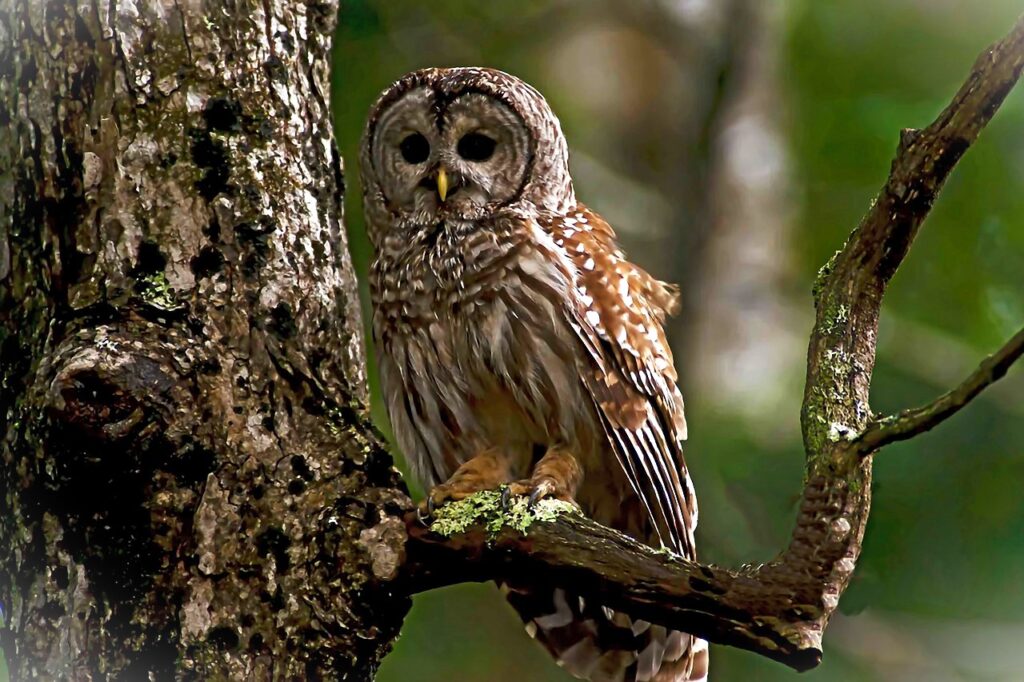Will feds decimate one owl species to help another?
Bonner Cohen, Ph.D.
CFACT
Nearly 500,000 barred owls in northern California, Oregon, and Washington state will soon be under the gun if the U.S. Fish and Wildlife Service goes ahead with its latest scheme to save the endangered northern spotted owl.
In November, the Fish and Wildlife Service unveiled its barred owl management proposal, the centerpiece of which is the removal of approximately 500,000 barred owls via the shotgun or other forms of euthanasia from the habitat of its smaller cousin, the northern spotted owl.
“Barred owl removal is not something the Service takes lightly,” Jodie Delavan, a spokeswoman for the Oregon Fish and Wildlife Service, told McClatchy News on March 26. “However, the Service has a legal and ethical responsibility to do all it can to recover northern spotted owl populations.” A final barred owl “management strategy” and a record of decision is expected later this year, Ms. Delavan told McClatchy News.
Since the barred owl is protected by the Migratory Bird Treaty Act, killing them — in this case, by the hundreds of thousands — will require a federal permit or regulation. And that is a step the feds appear to be prepared to take.
That the barred owl is covered under the Migratory Bird Treaty Act is quite appropriate because the bird — beginning in the early 20th century — began migrating westward from eastern North America. By the 1980s, it was well established in the Pacific Northwest, where it occupies the same habitat as the smaller northern spotted owl. The two species feed on the same prey, with the more aggressive barred owl outcompeting its cousin, sometimes even killing northern spotted owls.
When the problem first garnered public attention in the early 1990s, the preferred explanation from the U.S. Fish and Wildlife Service and environmental groups was that the commercial logging of old-growth forests was responsible for the loss of the northern spotted owl’s habitat and thus was behind the bird’s dwindling numbers. Saving old-growth forests, where Douglas fir and hemlock prevail, was seen by the Clinton administration as the preferred solution, and policies were put in place that restricted logging on federal land in the Pacific Northwest. Those policies succeeded in shutting down many sawmills and destroying timber-dependent communities throughout the region.
The Clinton administration even orchestrated an “Owl Summit” at which federal officials and environmentalists congratulated themselves for caring so much about the fate of the northern spotted owl. Those who pointed out that the problem lay not with old-growth forests but with the encroaching barred owl were ignored.
Over 30 years after the summit and the bird’s being added to the Endangered Species List, the situation faced by the northern spotted owl has worsened. While ignoring the mistake it made in blaming the loss of old-growth forest for the northern spotted owl’s declining numbers, the feds now acknowledge that the problem lies with the barred owl. Seizing the bull by the horns — to mix metaphors — the Fish and Wildlife Service initiated an experiment that involved the killing of 2,485 barred owls with 12-gauge shotguns in five different areas, the Modesto Bee reported March 26.
Having concluded that nonviolent removal of the barred owls was impractical, the feds appear to have settled on a lethal approach. This means showing a preference for one species of owl over another, with the “invasive” barred owl coming up short. But is the barred owl really an invasive species, or is it simply expanding its territory, as many species of birds and mammals are prone to do?
The Owl Research Institute, a Montana-based nonprofit focused on owl conservation, is reviewing the government’s proposal.
“Central to this discussion is the determination of whether Barred Owls truly meet the criteria for an invasive species, or if they represent a more adaptable species capable of natural expansion by themselves, as some have suggested,” the institute said in a March 26 statement emailed to McClatchy News.
The Fish and Wildlife Service is operating under the 1973 Endangered Species Act, a statute that has fallen woefully short in fulfilling its mission of recovering species at risk. In the case of the northern spotted owl, the law was used in the 1990s to curtail commercial logging in the Pacific Northwest. That was a political goal pursued by environmentalists in and out of government. As is now clear, it did nothing to improve the lot of the northern spotted owl.
Today, federal wildlife managers are seriously considering an avian version of ethnic cleansing to carry out their “legal and ethical responsibility” under the Endangered Species Act. The statute allows bureaucrats to play God, even if their policies turn out to be ungodly. If they go through with their plan and shotguns are trained on hundreds of thousands of owls, the Endangered Species Act will have reached a new level of absurdity.
As posted by CFACT
Subscribe to RANGE magazine
Call 1-800-RANGE-4-U
You may also like
-
Electric Vehicles: A pipe dream for tyrants
-
Ecologist goes undercover to expose eagle deaths cause by wind turbines
-
BLM resource management plans stymie Western states’ energy development
-
Foot deformities in Texas foals caused by effects of nearby wind turbines
-
Groups sue Biden Administration to protect Right Whales from offshore wind project


